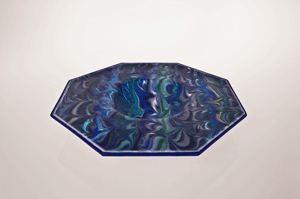Fused: Klaus Moje
Fused: a journey from artists in the National Art Glass Collection

- Klaus Moje Blue octagonal plate #3 1986, cut fused mosaic blue, grey and teal, glass slumped
Cultural Background
Both of my parents were born in Hamburg, Germany
Place of Origin
Hamburg, Germany
Start of Migration Journey
Hamburg, Germany - August 1982
Place of Arrival in Australia
Sydney, NSW – August 1982
First Home in Australia
Watson, ACT
First job in Australia
Founding Head Of Glass Workshop and Senior Lecturer - Canberra School of Art, Australian National University
Other Jobs in Australia
Free lance Artist since 1992
Any glass related objects that you brought with you? And still have?
I bought quite a number of tools and glass related objects, most have been given to Australian Public collections
Klaus's story
At the age of fifteen I started a three year apprenticeship as a glass cutter and grinder at the family workshop in Hamburg. The business belonged to my father who worked with mirrors and grinding techniques doing edges and facets. When my contract was completed I received a Journeyman's Certificate, which is a very intensive course and learning time for apprentices. After moving to Munich and five years as a Journeyman I was then qualified to apply for a Masters Course, which I did at the Rheinbach & Hadamar glass schools.
In 1982 I received a call from the then Director of Canberra School of Art, Udo Sellbach, he asked me if I would be ready to start a Glass Program at Canberra School of Art. I said from the beginning that I would do teaching because I felt that I needed to give something but I did say that there would be a limit to my involvement, which would be ten years. I accepted with the provision that I start the department from scratch; otherwise I would not have taken it on.
That same year I arrived in Australia together with my wife Brigitte and my daughter Mache from an earlier marriage. The program that we started was different to anywhere else in the world because it was not focused on the hot glass workshop. This is why Canberra School of Art has become very well known around the world; we applied a quality to glass that was not seen at that point in other educational programs.
I have visited and taught at Pilchuck Glass School in the USA since 1979. One of the first things that I did when I arrived here to establish the glass program was to approach the Australia Council and ask them to provide a scholarship for Australian students to go to Pilchuck. This was something unknown at the time because the Australia Council was not funding education but they agreed to open up two scholarships per year and for quite a long stretch of time. So this meant a student could go to Pilchuck and experience the international glass community and international knowledge. This enabled them to come back to Australia with this knowledge and pass it on to others.
We have twin sons, Amos & Danilo. Amos studied at Canberra School of Art and continues to work with glass. About sixteen years ago Brigitte and I relocated our studios from Canberra to Wapengo near Tanja on the south coast, which is where we currently live and work.
In 1995 I received the Australian Creative Fellowship, known as the Keating Award, which was a great help to fall back on my feet after completing the appointment at Canberra School of Art. Among others, two outstanding awards I have received were the Life-Time Achievement Awards from the Glass Art Society (2000) and Urban Glass (2004) both in the USA.
In 2006 I received an AO (Order of Australia), which is unusual as I am still not yet a citizen hence this meant I became an Honorary Officer. Of course I still have commitments to Germany but I have had my greatest success here in Australia with what I have introduced and developed so I would like to have citizenship.
My experience with Australia has been an absolute positive one and this country has rewarded me in a wonderful way for what I have achieved and others who have helped me as well. It has been a fantastic wave that I have been riding on which includes the people that I have been dealing with.
I am very happy to see what has grown in this country over the last twenty years. The glass scene here has risen to such a high appreciation internationally, that is there because the people are here and because there is a different attitude. This only needed to be awakened; fortunately for me it was already there to begin with.